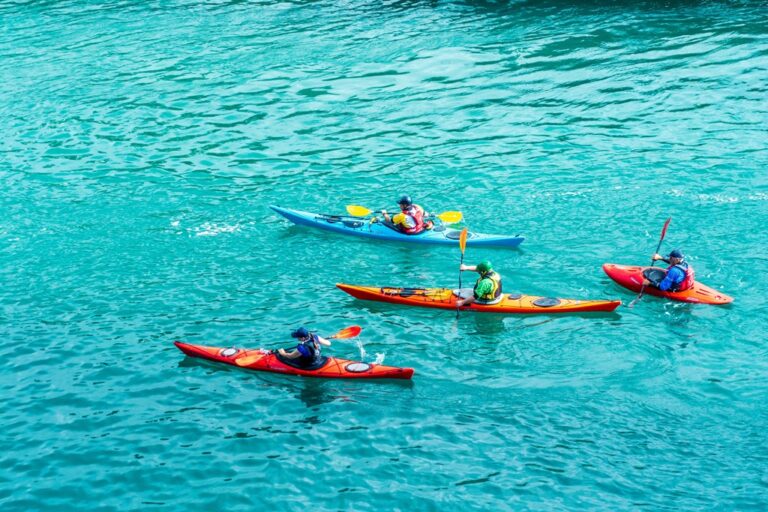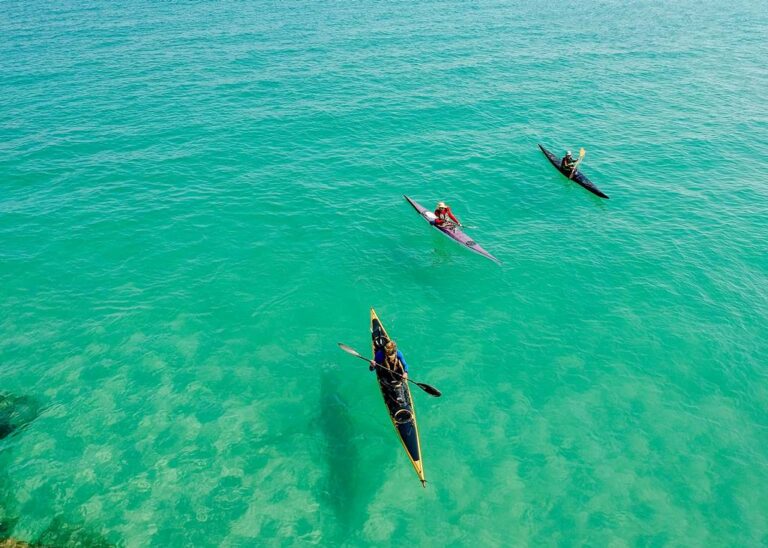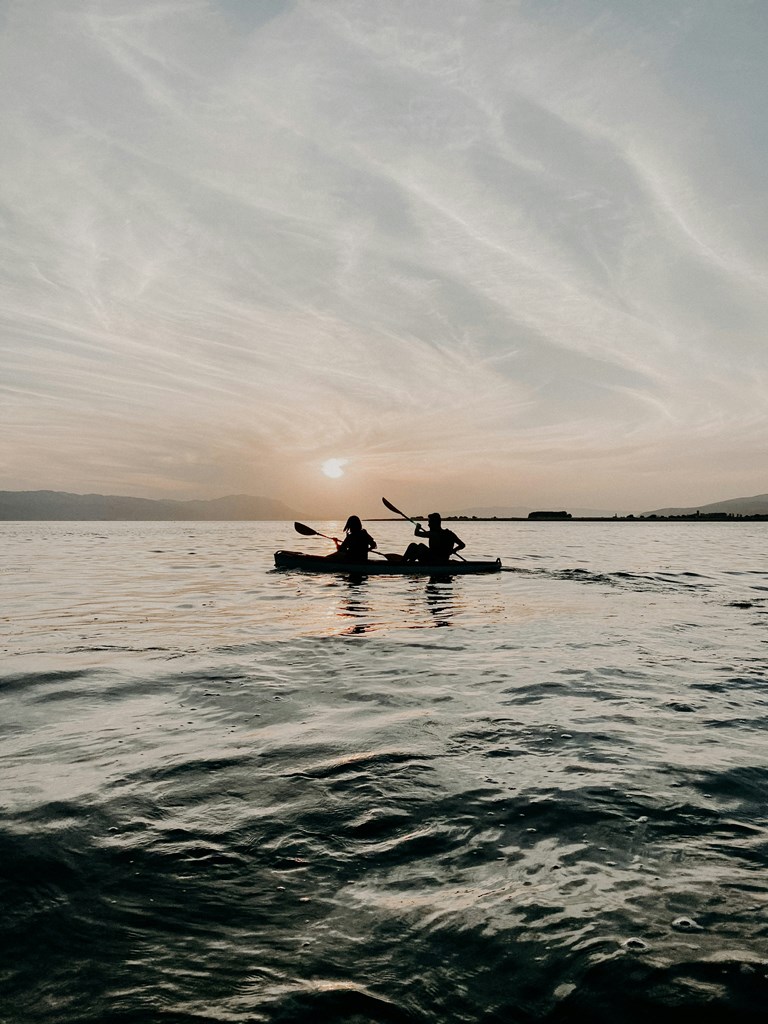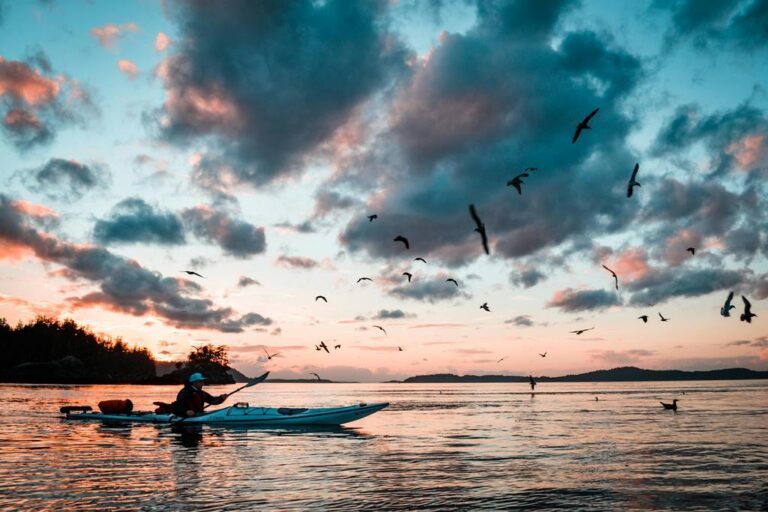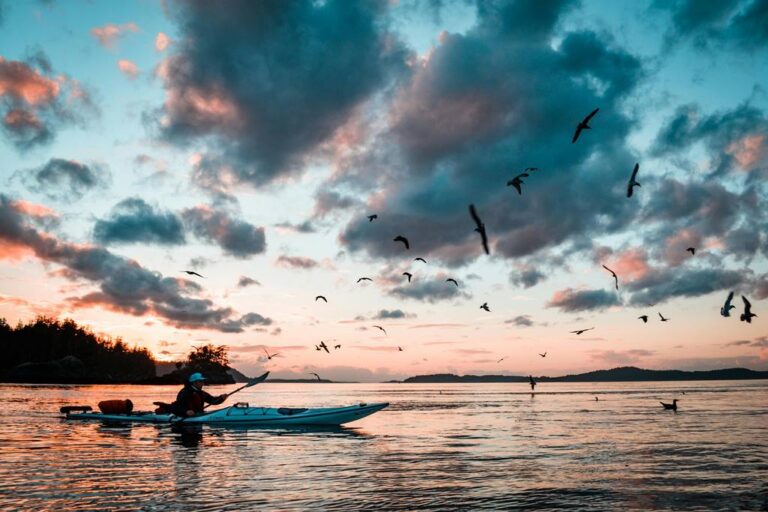
Kayaking is often seen as weather-dependent, but you can still enjoy it in most conditions. Rainy Day Kayaking can be just as fun as paddling on sunny days, though some weather can make your outing less enjoyable and even dangerous.
Take rainy weather, for example. Many kayakers avoid the water when it rains, but some adventurous paddlers don’t let a little rain stop them. If you’re in that second group or want to be, you should know that gloomy weather brings more potential risks.
But don’t worry—you can still have a safe and fun kayaking trip in the rain. You just need to plan a bit more carefully, pack some extra essentials, and be ready for different scenarios.
In this guide, I’ll cover everything you need to know about kayaking in the rain: how to prepare, what to wear, what to bring, and more. I’ll also answer common questions to help you enjoy your rainy-day paddle.
Table of Contents
Should You Kayak When It’s Raining?
Yes, you can kayak in the rain, but there are a few important things to consider first. Is it just a light drizzle or a heavy downpour? Are there any thunderstorms in the area? How rough are the waters?
While kayaking in the rain can be enjoyable, safety depends on the conditions. Paddling in a thunderstorm is a big no-no since the risks are too high.
You also need to be well-prepared—more so than for a regular trip. Weather can change quickly, so be ready for anything. Proper planning is key to ensuring a safe and enjoyable rainy day on the water.

Is Kayaking Safe After Rain?
Kayaking after it rains is possible, but you need to be extra cautious. The water level will be higher, there could be fallen branches and debris, and the area might look and behave differently, often in ways that make paddling riskier.
Before you head out, take some time to scout the area, even if you know it well. Check how the water levels have changed and look for any new obstacles you’ll need to avoid. This extra step can make a big difference in ensuring a safe and enjoyable trip.
Kayaking in Rain: What to Watch Out For
If you’re planning to kayak in the rain, here are some risks to keep in mind that can make your adventure dangerous:
Flash Floods
Heavy rainfall can trigger flash floods, and they come on so fast that there’s no time to prepare if you’re caught in one.
In an instant, a small, gentle river or stream can turn into a raging torrent, making it nearly impossible to navigate. Floodwaters are incredibly fast and powerful—definitely not something you want to experience while kayaking.
Lightning
Lightning storms are breathtaking, but it’s best to admire them from a safe distance. Kayaking during a storm is a bad idea, and most kayakers avoid the water in such conditions.
However, weather can be unpredictable, and you might find yourself caught in a storm.
Kayaking in a storm puts you at risk of being struck by lightning.
While the odds of a lightning strike are generally low, they increase significantly when you’re on the water holding a paddle, which conducts electricity. Plus, in open water, your body becomes the tallest object around, further raising the risk.
Poor Visibility
Sometimes, bad weather brings low visibility, making it tough to see where you’re headed. This increases the chances of hitting something, like a rock or other large obstacles—or even colliding with a bigger motorized boat.
None of these scenarios are ideal, especially with heavy rain and overall poor conditions.
Heavy Winds & Rough Waters
When the rain is pouring heavily, you can expect strong winds and rougher waters.
This makes it harder to control your kayak, especially if you’re paddling against the wind. You might end up getting too exhausted to make it back to shore—an unnerving situation no one wants to face.
Cold and Hypothermia
Kayaking in icy water and cold weather presents a serious risk. If you fall in without proper gear, you’ll experience cold shock.
Cold shock makes your breathing rapid and uncontrollable, causing you to gasp for air and possibly take in water. This makes it difficult to swim or get back into your kayak. In such a situation, the risk of drowning is high, especially if you’re not wearing a life jacket.
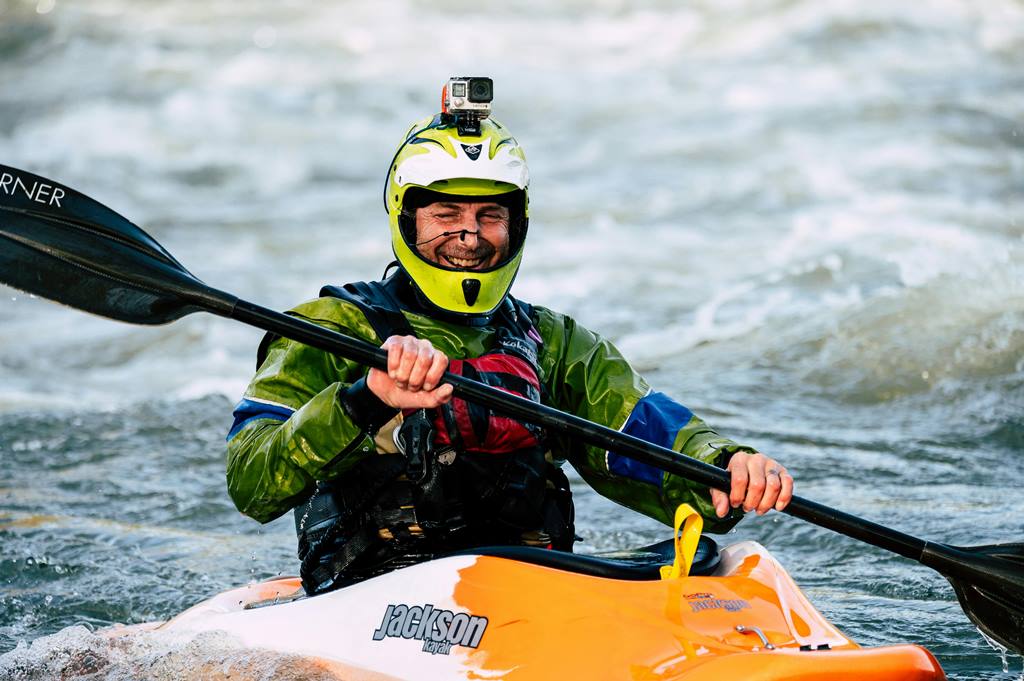
Rainy Day Kayaking? How to Stay Safe
We’ve covered the risks of kayaking in the rain. Now, let’s focus on how to stay safe and still enjoy your time on the water, even in rainy weather or if you get caught in a downpour while kayaking.
Get the Weather Forecast Report
The key to safe kayaking is preparation, and you can’t prepare for what you don’t know.
Checking the weather forecast gives you a heads-up on what to expect, so you can be ready. Knowing the weather helps you avoid unpleasant surprises.
Weather forecasts might not be perfect, but they’re still crucial. For example, if strong offshore winds and heavy rain are predicted, you can plan to stick close to the shore. This way, you can easily get to safety if conditions become too challenging.
The forecast also tells you when to avoid kayaking altogether. If a serious thunderstorm is on the way, you’ll know to stay off the water and save your adventure for another day.
Map Your Way: Plan your route
Once you have an idea of the weather and water conditions, use that information to plan your route. Stick to easier locations and keep it simple in case the weather changes unexpectedly.
Map out several exit points along your route so you can quickly get out of the water if needed. If you hear thunder, it starts pouring, or conditions get too rough, it’s time to exit.
In bad weather, it’s also wise to make your trip shorter. You don’t want to be out on the water for too long when conditions are less than ideal.
What to Wear? According to Weather
If it’s raining, you’re likely facing cold weather and chilly water temperatures. One of the biggest risks of kayaking in the rain is hypothermia.
You need the right rain gear to stay warm and dry. Always be prepared for the possibility of falling in the water. Without proper thermal clothing, a sudden plunge can cause cold shock as your body temperature drops quickly.
Layer up to stay warm, whether you’re paddling or taking an unexpected swim.
Now, when it comes to what to wear, should you choose a dry suit or a wetsuit?
Wetsuit Vs. Drysuit for Rainy Weather Kayaking
Wetsuits and dry suits are essential gear for staying warm in cold weather, and they’re popular with water sports enthusiasts.
A wetsuit fits snugly and keeps you warm by trapping a thin layer of water against your skin, which your body then heats up. In contrast, a dry suit is completely waterproof, keeping you dry even in the rain.
Surfers and those who spend a lot of time in the water usually opt for wetsuits. Meanwhile, kayakers and paddleboarders tend to prefer dry suits to stay dry and comfortable on their adventures.
Your Visibility
Bad weather often means reduced visibility, so it’s crucial to make sure others can see you. Wearing bright colors helps you stay visible on the water.
Collisions with other vessels are common accidents, and staying visible is key to avoiding them. As a kayaker, you’re in a smaller vessel, and an accident could have serious consequences.
For extra safety, consider using kayak lights to ensure you’re seen even in low-light conditions.
Spray Skirt Essential
Spray skirts are essential for keeping water out of your kayak, creating a dry environment and helping to keep your legs and feet warm.
If you kayak in the rain without a spray skirt, your kayak will quickly fill with water, adding an extra challenge to your adventure.
It’s also worth noting that a sit-in kayak is better than a sit-on-top for rainy weather. A sit-in kayak provides a warm and dry cockpit for your lower body and any gear you’re storing, making your trip more comfortable and enjoyable.
Self-Rescue
We don’t recommend beginners go kayaking in rough weather. You need to be skilled in reading the water and weather and navigating various conditions.
More importantly, you should know how to self-rescue if you capsize. Spend time honing your skills in a safe environment before heading out on a kayak trip in challenging weather.
Safety Essentials for Everyone
The usual rules for safe kayaking still apply when you’re out in the rain.
Always wear your life jacket—it should be USCG-approved and fit snugly. Safety gear is essential, so don’t forget to bring your phone and a whistle in case you need to call for help.
A crucial safety tip is to know your limits. If conditions get too rough, it’s better to end your trip early. Don’t wait until it’s too late to get off the water
Safe Trip! Leave a Float Plan
It’s important to share your float plan with a friend or family member before heading out on your kayaking trip. Let them know your itinerary and expected return time.
This way, if you’re not back as scheduled, they’ll know where to find you or alert authorities if needed. It’s crucial to stick to your plan as much as possible for everyone’s peace of mind and safety.
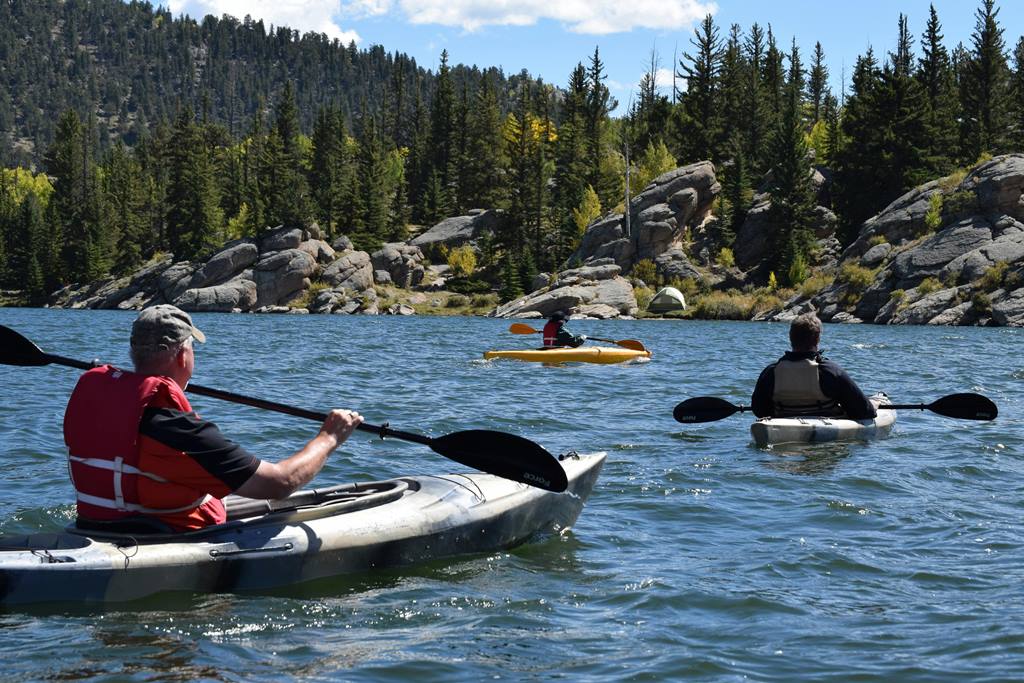
Go With a Friend
Kayaking with a friend is safer, especially when the weather turns bad. Having a buddy means there’s someone to assist if one of you encounters trouble.
While kayaking solo has its advantages and can be safe with the right precautions, bad weather increases the risks. It’s wise to go with a kayaking buddy in challenging conditions for added safety and peace of mind.
Kayaking Essentials Items for Rainy Days
When kayaking in rainy conditions, it’s crucial to be prepared with essential gear to ensure safety and comfort.
- Bilge Pump: Keep a bilge pump handy to quickly remove any water that enters your kayak. Sitting in a wet cockpit can be uncomfortable and potentially dangerous if water accumulates.
- Waterproof GPS: In rainy weather, visibility can be poor and using a phone for navigation becomes difficult. A waterproof GPS ensures you can navigate accurately without the risk of water damage to your electronics.
- Quality Dry Bag: A reliable dry bag is essential to keep your valuables and spare clothes dry in case of a capsize. It provides a secure and waterproof storage solution for your essentials.
- Headlamp: A headlamp is versatile—it enhances your visibility in low-light conditions and serves as a light source if you find yourself kayaking after dark. It’s a safety must-have for rainy days on the water.

